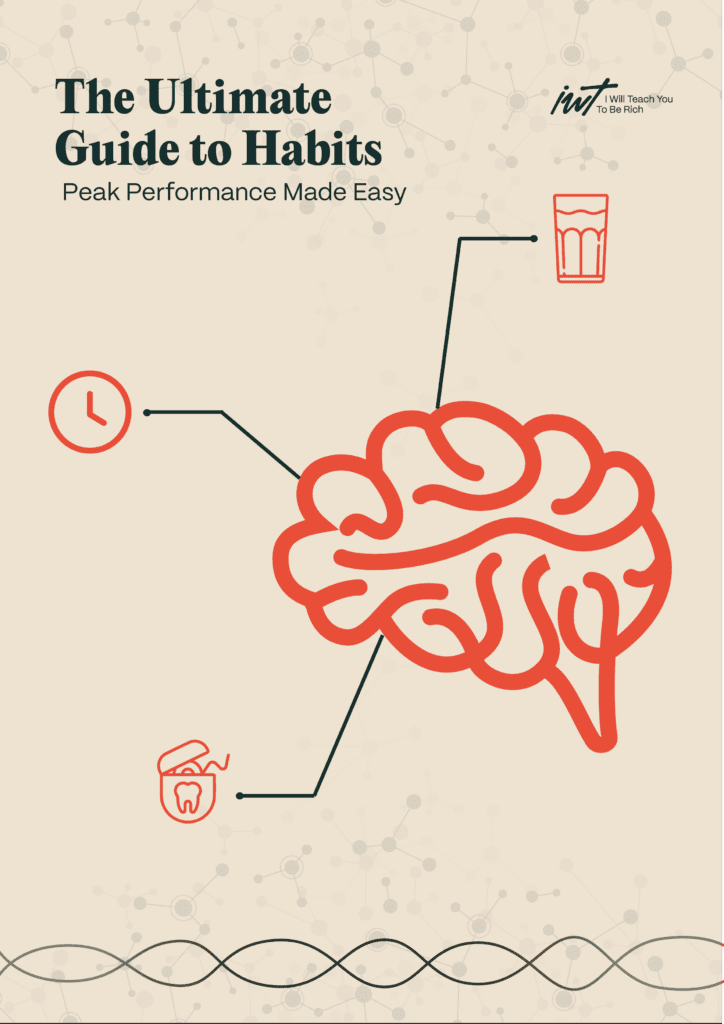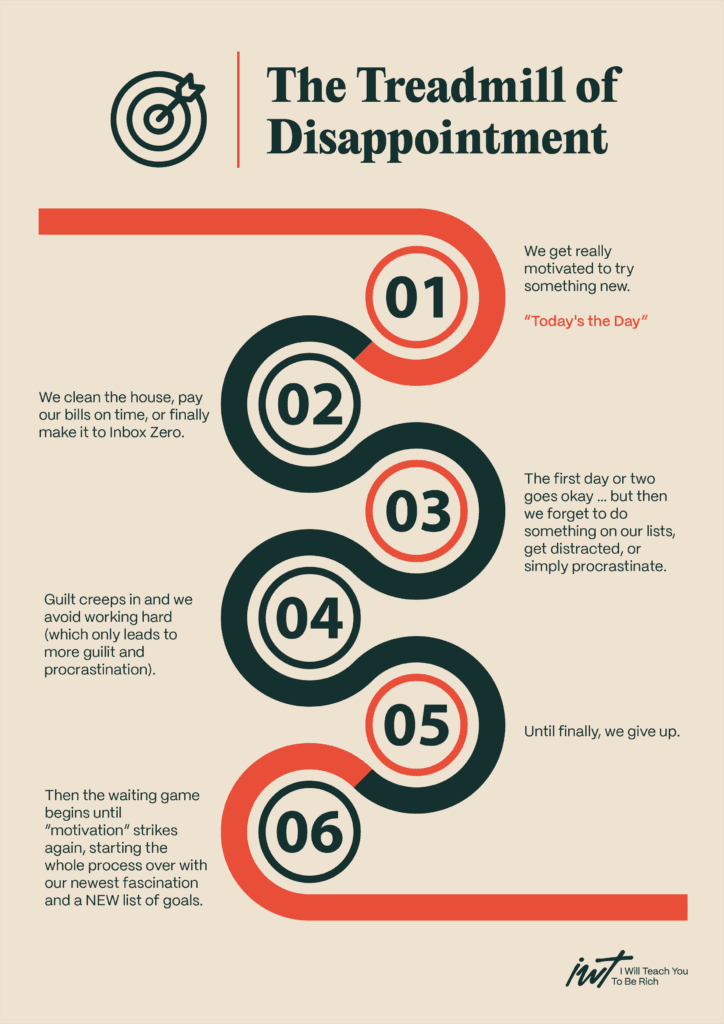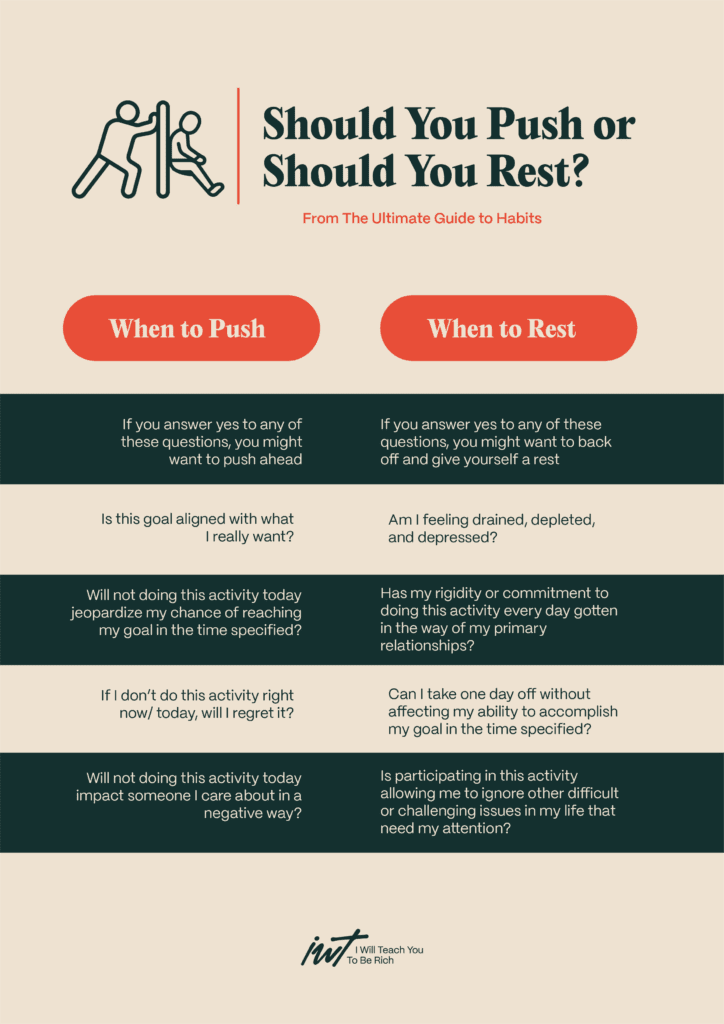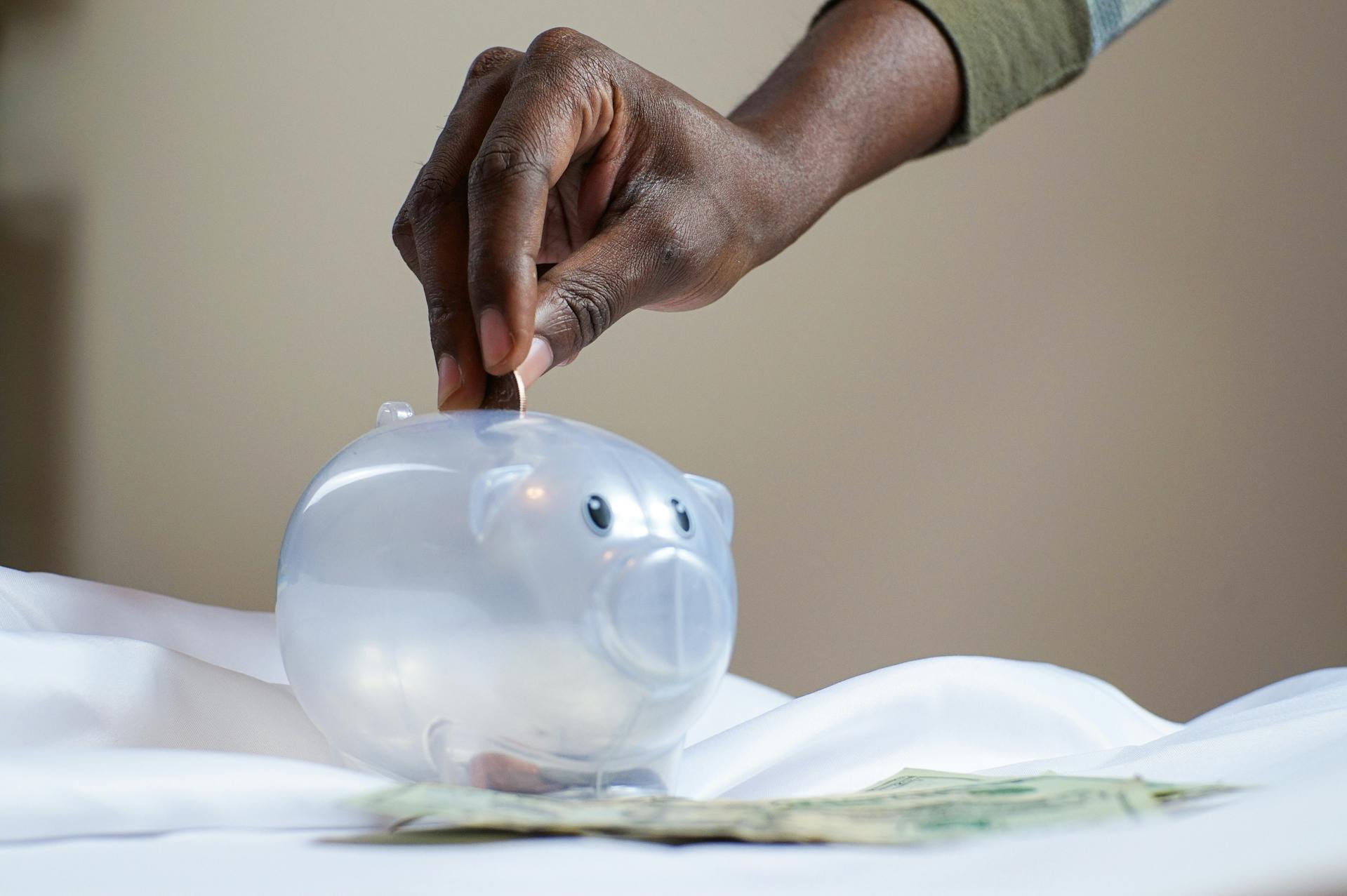
The Ultimate Guide To Habits
By reading this Ultimate Guide you’re already taking the first steps on your journey to a Rich Life. This is only an introduction to the ideas and material you’ll find in this article.
I started this site in 2004 while I was studying technology and psychology at Stanford. I’ve spent the time since testing and honing my Rich Life systems on thousands of successful students.
At IWT You Will Learn:
Buy all the lattes you want!
A $5 coffee is not going to change your financial life. But learning how to automatically invest, how to select the right asset allocation, and how to negotiate a $15,000 raise will. I believe in asking $30,000 questions, not $3 questions.
Your Rich Life is yours
A Rich Life can be picking up your kids everyday from school. Or buying a $1,000 cashmere sweater. It can be buying a round of drinks for your friends, or traveling for 8 weeks per year. You decide. Your Rich Life is yours. (Here are some of my Money Rules.)
There’s a limit to how much you can cut, but no limit to how much you can earn
I have readers who earn $50,000/year and ones who earn $750,000/year. We’ve helped tens of thousands of people earn more money by negotiating their salaries, investing, and starting businesses.
Spend extravagantly on the things you love, as long as you cut costs mercilessly on the things you don’t
I don’t believe in cutting back on lattes. In fact, I want you to spend more on the things you love. What if you could double your spending on travel, or eating out, convenience, or charity? I call those Money Dials and I’ll show you how.
The 85% Solution
Getting started is more important than becoming an expert. You don’t need to be perfect to take control of your money. It’s OK to make mistakes. Get 85% of the way there and move on with your life.
Investing should be very boring
And very profitable—over the long term. I get more excited eating tacos than checking my investment returns.
Money is political
You can simultaneously acknowledge personal responsibility and real systemic problems. This is a core part of the I Will Teach You To Be Rich philosophy. Housing is political. Healthcare is political. Voting rights are political. If you’re looking for bland tips on cutting coupons, this site is not for you.
I consider it a tragedy to live a smaller life than you have to
So many of us have been raised to believe that money is something to be scared of. We use phrases like “I’m not good with money” or “Money changes people.” Yes, money does change people. Money allowed me to dream bigger, to be more generous, and to be more adventurous. It can do the same for you.
A Rich Life is lived outside the spreadsheet
What’s the point of all this saving and investing if you’re simply going to wait until you’re 80 to live? No thanks. I believe that once you’ve set up your finances, you’ll see that the most important part of a Rich Life is outside the spreadsheet—it involves relationships, new experiences, and giving back. You earned it.
Welcome to your Rich Life journey, I’m excited to see what you do next!
* Watch founder Ramit Sethi on Netflix
* Get the NYT-Bestselling book
* Check out the hit podcast
And join over 800,000 readers getting our Rich Life Insiders newsletter:
Do you ever wonder how the most successful people get so much done?
When they say, “I’m going to…” lose weight, write a book, quit smoking, etc., you know they’ll actually do it. But when you set the same goals, you’re not so sure. Maybe you will do it.
Maybe not. Each time you try, it’s a yo-yo. You start, hit a roadblock, lose motivation, then beat yourself up for not finishing. Over and over and over again.
It’s frustrating and discouraging. Worst of all, you’re not doing the things you really want to accomplish.
The truth is, you’re more than capable of achieving every goal you set.
But if you really want to accomplish the goals you set, you need a better strategy for getting things done. A proven system that helps you stick to — and finish — everything you start.
That’s exactly what I have for you in this free guide: a proven system that’s helped me write a New York Times best-selling book, build a multimillion-dollar business, put on 40 pounds of muscle, and live a Rich Life.
Even more fundamentally, it helped me filter through the millions of possibilities out there, ignore all the distractions, and get started on my biggest goals in life.
Are you ready to achieve any goal you have with less effort?
Let’s get started.

Why I wrote this guide to habits
Ten years ago, I was a scrawny 127 lb college student. I thought I could never put on muscle because I’m just a skinny Indian. I spent years wishing I could, without doing a thing about it.
Do you know what changed?
I got tired of looking around, watching other people get fit, and feeling left behind. I finally said ENOUGH! and did something about it. I invested in a trainer and made working out a habit. I built a system that virtually guaranteed my success.
Since then, I’ve put on more than 40 lbs of muscle, which feels amazing. And it’s crazy to think about how far I’ve come. I’ve used these same habit-building techniques to earn more money, grow my business, and live a Rich Life.
I stopped dreaming and started accomplishing!
Now I want you to experience this radical shift in your life — no matter how many times you might have struggled to stick to your goals in the past.
How many times have you said to yourself:
- I’m going to start working out 5x a week
- I’m going to eat less processed foods
- I’m going to start drinking 8 glasses of water a day
- I’m going to floss every morning and night
And how many times have you followed through on those goals?
If your answer is “not often enough,” don’t worry. It’s not your fault. And with the systems, frameworks, and strategies laid out in this free guide, you can easily change that. You can learn how to make your habits stick for life.
Once you know how to do this, you virtually guarantee success in everything you do — from this moment forward.
In this guide you’ll learn:
1.Goal-Setting… the Right Way
Most people don’t know how to set good goals. They just think of something they want and then start “trying” to make it happen. When it doesn’t, they’re left wondering what went wrong. In Part 2, I’ll teach you the best way to set and reach your goals.
2. Create Keystone Habits Using the Habit Loop
Have you ever wondered why it’s so tough to make little changes in your life? And why some people seem to be able to do it with ease, while others fail to follow through time after time? In Part 3, I’ll teach you a simple system that makes forming and keeping new habits effortless.
3. How to Make Any Habit Last Forever
Do you ever say to yourself, “Why did I lose my motivation?” In Part 4, I teach you why relying on motivation is a loser’s game — and what to do if you ever get off track.
4. How to Get Back on Track
Once you’ve successfully started a habit, how do you keep it going? In Part 5, I’ll teach you why sometimes, simple systems break down and how you can get back on track towards lasting behavioral change.
5. How to Stay Laser-focused on Achieving Your Goals
Sometimes the hardest part of accomplishing your goals is being able to see the big picture and having the wherewithal to stay laser-focused until you’re done. In Part 6, I’ll show you the best tips for staying locked in on your Big Wins.
6. Using Behavior Change to Live a Rich Life
At this point, you’ll have learned from some of the top behavioral experts on how to succeed faster than you thought possible. You’ll also have learned some of the key strategies you need to create lasting behavioral change.
You’re missing the full experience! The original, unabridged version of this guide is available to download as a PDF. It’s 100% free – just tell us where to send it.
1. Goal-Setting… the Right Way
When it comes to setting goals, a lot of us experience what I call:

Not the best way to move the needle on what’s most important to you. The good news? You can get off this treadmill.
Let me show you a better way of setting goals so you achieve what you set out to do. A way that sets you up to win without ever giving up
3 Easy Steps to Achieve Any Goal You Set
Tip #1: Ride the motivational wave
One of the most important “hacks” I ever learned for achieving my goals was to “ride the motivational wave.”
Remember the last time you cleaned your whole house? That’s a motivational wave. “Motivational waves” are those moments where we feel really inspired to take action on a list of to-dos. I learned this from one of my mentors, BJ Fogg, who runs Persuasive Technology Lab at Stanford.
In this video, Fogg explains how to use these “motivational waves” to your advantage… rather than getting really motivated and falling back into our old ways of doing things a few days later.
Example 1:
BJ Fogg’s goal was to drink more tea. So when his motivation was at its peak, he bought a bunch of tea, an electric kettle to boil water, and set everything up in easy-to-reach places on his kitchen counter. He built a system so that it was a no-brainer to make tea whenever he was in the kitchen.
Example 2:
A few years ago, my goal was to form a gym habit. The problem I had was that I’d get up in the morning planning to go to the gym, but after a few minutes of being awake, I’d decide not to go. So, the next time I was feeling really motivated, I built a system. It looked like this: I put my gym clothes and my shoes next to my bed so I saw them first thing in the morning. As soon as I got out of bed, I would get dressed. By the time I finished putting on my clothes, I’d think to myself, “Well, might as well go to the gym,” and I DID!
These types of systems guarantee success. THAT’S what you should use your motivation for — to set up fail-proof systems. That way you’ll follow through even when you’re no longer motivated.
Goal-Setting Action Step:
Feeling “motivated” right now? Use that to your advantage. Make a list of everything you need to get in order to accomplish your goal.
Then, sketch out a rough outline of your fail-proof system that’ll help you follow through on your goal (like the examples above).
We’ll go into much more detail of how to set up fail-proof systems later in the guide, but don’t let that motivation go to waste. Capture your rough ideas whenever your motivation is at a peak.
Tip #2: Start small, then go big later on
When you’re starting out with any goal — like exercising — it’s better to actually start than to dream about starting forever.
With each little milestone you achieve, you’re doing what you set out to do.
With exercising, that means ACTUALLY walking one mile once per week is better than PLANNING to run three miles 3x per week… and never running at all.
Each mile you walk represents a “small win” for your goal. And getting a lot of those little wins is what helps you succeed. Because with each little milestone you achieve, you’re actually doing what you set out to do… not just hoping things work out.
- Instead of planning to do 100 pushups per day to get back in shape, just do two pushups a day to get started.
- Instead of trying to drink a gallon of water a day instead of soda, just drink one glass of water before you go to bed.
- Instead of thinking you have to floss all your teeth, just focus on one tooth a day to get things going.
- Instead of starting a million-dollar business from scratch, just focus on getting your first paying client.
You can ramp up from there. But you don’t want to fail from the start.
Goal-Setting Action Step:
Think of some of the goals you’d like to accomplish (getting fit, learning a new language, cleaning your house). First, break your goals down into the TINIEST steps you can imagine. And I mean SERIOUSLY tiny: 2 pushups per day, 1 tooth, 1 glass of water… however small you need. Make it something you KNOW you can do.
Draft up a plan for how you’ll do this for 2 weeks. Once you hit this target, then you can consider expanding. But remember, big goals are accomplished with tiny steps. How can you start taking some of those tiny steps today?
Tip #3: Put it on your calendar
Imagine you’re playing in a basketball game against LeBron James. You have the best shoes, the most expensive pair of athletic shorts, a fancy headband, and the greatest jersey in the world. And he has no shoes, ripped shorts, and a dress shirt.
Who would win? LeBron, duh.
It sounds ridiculous, right? But we play this same game against motivation every day.
The tools don’t matter as much as we think.
Novices LOVE to focus on productivity hacks, apps, and tools. It’s easy — and frankly, more fun — to play with new shiny tools than to simply do what works.
But usually, the fundamentals — things like a simple calendar, pen, and paper — work just as well, if not better, than some app.
Take a look at my calendar system.
See how it’s not a super advanced set of apps? I purposely make it easy on myself so I can follow through and easily update it. EXECUTION is more important than the tactic itself.
Goal-Setting Action Step:
Here are three things you can do today to help you achieve your goals:
- Map out your schedule for the week either on paper or in a simple calendar system.
- Put your baby steps goals into your calendar system.
- Then, set an alert in your calendar or on your phone to review this every week.
If you keep thinking ahead, you’ll never be caught off-guard or pressed for time. Those tiny improvements every week will add up. And it won’t be long before you’re crushing every goal you set. Learning how to set goals like this increases your chances of making your habits stick.
2. Create Keystone Habits Using the Habit Loop
Create Keystone Habits Using the Habit Loop
Wouldn’t it be great if you never had to worry about hitting your goals? You could just do what you were supposed to do without even thinking about it. Sounds like a pipedream, right? But it’s possible, IF you know how habits work. When you do, you can take full advantage of them and put your success on autopilot.
The “Habit Loop” and how to use it to your advantage
According to Charles Duhigg, author of The Power of Habit, every habit has three components:
- A cue – Which is a trigger for a behavior to start (like your alarm clock going off).
- A routine – Which is the behavior itself (like getting out of bed).
- A reward – Which is the benefit of taking that course of action (like a nice, warm cup of coffee waiting for you when you get out of bed).
The reward is how your brain actually learns to want a particular behavior in the future. You put 2-and-2 together and equate the pleasure of drinking a cup of coffee with getting out of bed.
This is how people pick up bad habits, like smoking, but it’s also how people stick to good habits like exercising. They link a cue and routine to a reward. For decades, people focused exclusively on changing the behavior: the routine itself.
But now, we know that cues and rewards are actually the most important parts of making a habit stick. If you get the cues and rewards right, the routine forms by default. So choosing your reward — not the routine — is actually the most important step
Reward yourself MORE to create good habits
Eating chocolate can help you exercise more.
Yes, you read that right: Research has shown that eating more chocolate can help you stick to an exercise regimen.
Here’s why: Eating chocolate at the end of a workout is a simple way to ignite the reward centers in your brain. It cements the good feelings that make a habit take root.
It sounds contradictory (that eating chocolate and exercising go together), but it’s true. Why do you think a lot of really fit people drink smoothies or protein shakes when they finish working out?
It’s the same principle at work. The sweet drink acts as a reward for the behavior. Plus, it’s a little better for you than the chocolate.
I recently sat down with Charles Duhigg to talk about how to create new habits.
And in this part of our chat, he explains how important rewards are. The best part is you can choose your own rewards and easily make new habits stick.
The key takeaway? Always reward yourself.
You don’t want to end your workout, leave in a rush and not be able to reward yourself with a smoothie or a relaxing shower. Make sure you can give yourself a reward to make sure the behavior sticks.
Here are some rewards you might use to help create a habit:
- Give yourself 5-minute breaks for every 20 minutes of deep work you do
- Allow yourself to buy a nice pair of shoes after you hit your savings goal for a month
- Watch a TV show (guilt-free) after cooking a healthy meal
The reward can be anything you choose, as long as you’re giving yourself something you genuinely enjoy.
Change your routine to change your habits (why “quitting” doesn’t work)
It’s very hard to simply stop a bad habit. That’s because you’re always getting whatever cue was telling you to do the bad habit in the first place. So what can you do about it?
You’re much more likely to be successful if you change a bad habit into a better behavior.
Here’s a common example:
A lot of us crave something sweet to eat right after lunch. We hit the vending machine for chocolates, cookies, or some other sweet to get our fix. Because yes, sweets and desserts taste good, but a habit is much more complicated than that. Maybe getting that sweet gives you a burst of energy from the sugar so you can push through the rest of the day. Or maybe you’re not ready to go back to work so getting up for a snack gives you a chance to walk around the office and chat.
You’re much more likely to be successful if you change a bad habit into a better behavior. It’s not just the sweet that’s creating your behavior. There’s a whole series of reasons that surround it.
Instead of just giving up the sweets, maybe you could try getting up from your desk and eating an apple instead. Or maybe, if it’s the energy from the sugar that you’re craving, a cup of coffee will do the trick.
The important thing to note is that you’re not stopping cold turkey. Instead, you’re replacing a “bad habit” with a new, better one.
Over time, this will become your new routine. And doing it will kick in automatically after the cue.
- If you’re drinking too much coffee, drink decaffeinated tea instead.
- If you overeat when you’re feeling stressed, chew gum after you’ve eaten your regular portion of food.
- If you always hit the snooze button on your alarm clock in the morning, move your alarm to the other side of the room so you have to get out of bed to hit snooze.
Replacing bad habits can dramatically change your life. Not only do you stop doing the bad thing, but you pick up a better habit in its place. If you only do this, you’ll be 100x ahead of other people who can’t figure out why they never finish things.
But there’s another way to exponentially improve your life:
Do the most important habits first!
Keystone Habits
The Most Powerful Habits Of All
Some habits are much more powerful than others. We call them “keystone habits,” because they help lock other good behaviors into position, like the keystone in an arch.
Take exercise. For a lot of people, once exercise becomes a habit, they tend to start eating better and making sure they get enough sleep.
That makes sense, right? You don’t want to come in from your morning run and grab a bagel and cream cheese. You’re exercising to feel better, so it’s only natural that you’ll want the food you put in your body to help you feel better, too.
I also learned a very interesting fact: Once you start exercising habitually, you also start using your credit card less, doing your dishes earlier in the day, and procrastinating less at work.
It’s not like you’re making a conscious decision about this. Instead, for a lot of people, exercise is a keystone habit.
When they do it regularly, it starts to change their self-image. And when that changes, they start thinking of themselves as the type of person who wakes up and exercises every morning. And the type of person who doesn’t pull out their credit card, gets chores done, and doesn’t procrastinate at work.
Think about it. How many CrossFitters in your office do you know who regularly goof off or procrastinate at work?
Nailing down that first habit might feel nearly impossible if you’ve failed to make it happen in the past. But if you use the strategies I’ve shared so far, not only will you be able to create lasting behavioral change, but you’re also likely to build a lot of other habits automatically.
You can read the first chapter for free – just tell me where to send it:
3. How to Make Any Habit Last Forever
Have you ever said you were going on a diet? Maybe you stuck to it for a few days. Then, one day, you find a whole chocolate cake in your fridge. You say, “I’ll just have one piece.” And then, 3 hours later, all that’s left is an empty plate, a few crumbs, and a lot of guilt. Why does this happen?
Why is sticking to good habits tough, even with solid commitment?
Jerry Seinfeld knew why, and he also knew the secret of lasting change: building momentum. Check out this story that explains how Jerry is able to stay so productive and prolific throughout his career.
This is how Jerry stays on track to make sure his habits last even when he faces tough challenges:
“He told me to get a big wall calendar that has a whole year on one page and hang it on a prominent wall. The next step was to get a big red magic marker.
He said for each day that I do my task of writing, I get to put a big red X over that day.
‘After a few days you’ll have a chain. Just keep at it and the chain will grow longer every day. You’ll like seeing that chain, especially when you get a few weeks under your belt. Your only job next is to not break the chain.’
‘Don’t break the chain,’ he said again for emphasis.”
I love Jerry’s “Don’t Break the Chain” calendar. It’s not just about doing something each and every day.
It’s about the cumulative effects of all of your habits. For example, maybe you had an extra busy week at work, and you didn’t get to the gym for 5 days in a row. You’ll look at that week on your calendar and see that you have no red Xs on it. However, when you expand your view, your calendar looks like a blood bath.
That’s what really counts. You just have to make sure that 5 days off doesn’t turn into 5 months.
How do you keep a habit going after a break in routine?
You go back to your plan.
Remember in Part 3 (How to Make Any Habit Last Forever), we talked about the 3 steps of the Habit Loop – the secret to creating powerful habits?
It might be that your cue is no longer working or that your reward is no longer doing its job.
This can happen if your life follows a different pattern for a few days, like it might when you’re out of town for a conference.
The way to get back on track with your habit is to revisit your habit loop, make sure your triggers are in place, that you’re still committed to the routine, and that your rewards are clear and pleasurable for you.
Setting up systems is the best way to keep yourself going. And to get the most from our efforts, we have to find the best system for us and then adjust if it’s not working.
4. How to Get Back on Track
Even the best-laid plans sometimes fail. That’s life, and you have to be prepared for it.
But these setbacks don’t have to knock you off-course permanently. Often, you can get back on track with some very simple fixes.
Here’s how to get a habit back on track, after it’s dropped off (in less than 3 minutes):
How to use “failure expectation” to stay on track after a setback
When I was applying to colleges, I noticed something interesting. A lot of the people I knew were applying to top schools, and if they were rejected they’d say:
“Whatever, I didn’t want to go there anyway.”
What!? I remember thinking:
“If you didn’t want to go, why’d you apply? And if you DID want to go, why give up so easily?”
I fully expected to get rejected from my dream school (Stanford). That’s why I outlined a plan of specific actions I’d take to get in even after they rejected me. I was going to send them updates on my coursework, my copywriting business, and press clippings of articles I wrote.
Getting a “no” was only the first step of the process.
That’s how it is in other areas of life as well. From selling to dating to business — to just about anything. We need to plan for failure, and keep that plan on track when rejection comes.
Every Top Performer does this.
James Altucher, author of Choose Yourself, talked about this process when we discussed how to deal with failure.
We all worry about failing on some level. But it’s how you manage the fear of failure that determines your success. Success, though, is a tricky subject.
Sometimes when we push through our fears and overcome challenges, we easily get what we want. Other times, it seems like things will never pan out. How do you know the difference? And how do you know when you should push through obstacles and when you should give yourself a break?
Should you change course or stick to your goal (even if you don’t want to)?
Maybe the habit you’re working on is running every day. You want to get ready for a marathon at the end of the year. You aren’t running 100 miles a week yet, but you’ve been consistently staying on track by running a mile a day for the past month.
Then one day you wake up, and you’re not feeling it. You put your clothes on, but you’re not in the mood. You grab your headphones, open the front door, even take your first step, and you still don’t want to do it.
How do you decide whether to push through or go back to bed?
Whether it has to do with building a running habit or any other goal that you’ve already deemed worthy of your pursuit, asking the following questions might help you out.

5. How to Stay Laser-focused on Achieving Your Goals
A couple of years ago, one of my friends asked me:
“What’s your number one goal?”
That question made me nervous. I didn’t want to answer. I was afraid that if I said my single most important goal, I’d be closing doors to all of my other goals. Of which there were many. I said this:
“I want to be a bestselling author, but I also want to generate revenue, and I want to do this and publicity and blah, blah, blah.”
He cut me off and said:
“Cut the BS. What’s your number one goal?”
Again, I hedged. But he pushed me and forced me to get crisp. He said:
“The number one goal.”
I said:
“I want this book to be a New York Times bestseller.”
We hate giving ourselves constraints because it feels limiting. It seems like we’re giving something up, and that’s exactly what it felt like in that moment. However, it’s also freeing at the same time.
Once I decided (declared out loud) that I wanted to become a New York Times bestselling author, I eliminated about 70% of my marketing plan. It became crystal clear what I needed to do in order to achieve my goal. I focused all of my attention on those things.
Once my book became a bestseller, then I could do a lot of the other things that I wanted to do. This was a classic case of moving up gradually, but of course, like we talked about in Part 3, our natural inclinations are to go big. What we need to do is to get crisp. Crisp about what exactly it is we want.
Why your dating goals are important, too
The dating world is another example.
Let’s say you’re single and you’ve had a few boyfriends or girlfriends. You meet someone and they ask you:
“Hey, what kind of people are you into? I know a lot of people, maybe I can set you up. What kind of person are you looking for?”
Most people would be super generic about that answer:
“Oh, well, I like girls who are smart and nice.” A girl might say:
“Oh, I like guys who are nice, maybe a little taller than me, and older.”
That’s super generic — and a super generic answer will get you a super generic date. In reality, you know exactly what kind of person you want. If you were being honest you’d say:
“I am looking for an Asian girl who’s 5’5”, between 25-33 years old, has a beyond entry-level job at a big tech company, has lived in other countries, and is into endurance sports.”
But nobody wants to say that because they’re afraid to limit themselves. We worry about closing the doors on other opportunities, but it’s like we’re worried about not getting 100%, when if we don’t choose, we won’t even get 1%.
If you want something big, it’s critical to make that initial choice to commit to a tangible and specific outcome. The good news is that once you do that, you apply that winning principle to the next item.
Here’s an excerpt from an interview I did with my longtime friend, Noah Kagan. He’s the one who called me out on my number one goal.
Noah is a master at helping people (and himself) get laser-focused on achieving their goals. Pay special attention at 3:53 where he talks about the strategy that has made him the most successful, financially and otherwise.
How to achieve your biggest goal in under 1 year
I want to challenge you to do what Noah said:
Pick the biggest goal that you want to accomplish in one year.
Maybe it’s to get 10,000 people on your list, run a marathon, finish your first Ironman, do 5 dead hang pull-ups, or lose 20 pounds. Whatever it is for you, declare it. And then mark your calendar for one year from today.
Next, break it down on a monthly and daily basis.
By doing this, your big, hairy, audacious goals become manageable and by having daily accountability built in, you can use it as a filter for all of your decisions. I work with a lot of people who want to start an online business. It’s a very exciting time for them — but it’s also challenging to know what to focus on, who to listen to, and what bright and shiny objects are worth their time.
So I ask them:
“What’s your number one goal?” If they say:
“I want to get 5,000 people on my list in one year,” then we have something very concrete to work with.
When they come to the group and say:
“I was doing such and such on Twitter the other day,” the group will immediately call them out and say:
“Is Twitter going to help you get to 5,000 people on your email list?”
In 95% of the cases, the answer is no. It might be more fun than doing what it takes to get to 5,000, but it’s not going to get them there.
Having that kind of focus is what has enabled me to grow my business from nothing years ago to now being a multi-million-dollar business with 30,000 students all over the world.
Limiting your options may seem scary, but if you do it, your chances of achieving your goal increase exponentially.
So, get laser-focused on what you want and then be willing to let everything else take a backseat. If you get it right, you can bring them back to the front when the time is right.
6. Using Behavior Change to Live a Rich Life
At this point, you’ve learned some of the key systems and strategies you need to create lasting change in your life.
You’ve also heard from some of the top behavioral change experts out there. Now, it’s time to apply what you’ve learned to living a Richer Life.
You learned the single best way of keeping laser-focused on achieving your goal, as well as the systems to achieve it. If you want even more help, check out my Success Triggers, Mental Mastery, and Finisher’s Formula programs to help you stay motivated, confident, and optimistic as you tackle your goals.
In Part 1 (Goal-Setting) – We learned how systems beat motivation every time when trying to form change your behavior and form lasting habits.
In Part 2 (Create Keystone Habits) – I showed you the Treadmill of Disappointment and we learned 3 easy steps to achieving any goal you set.
In Part 3 (Make Any Habit Last Forever) – We looked at Charles Duhigg’s Habit Loop and the 3 components of cue, routine, and reward, and how even chocolate can be a powerful motivator for positive behavior change.
In Part 4 (Get Back on Track) – We talked about to use “failure expectation” to stay on track after a setback and when to push and when to rest.
In Part 5 (Stay Laser-focused) – You learned Jerry Seinfeld’s system of building momentum, “Don’t break the chain.”
In Part 6 (Using Behavior Change to Live a Rich Life) – You learned the single best way of keeping laser-focused on achieving your goal, as well as the systems to achieve it.
Join over 800,000 readers getting content that’s not available on the blog, free:
Host of Netflix’s “How To Get Rich” NYT Bestselling Author, & Host of the I Will Teach You To Be Rich Podcast. I’ll show you how to take control of your money with my proven strategies so you can live your RICH LIFE.
Written by Ramit Sethi
Host of Netflix’s “How To Get Rich” NYT Bestselling Author, & Host of the I Will Teach You To Be Rich Podcast. I’ll show you how to take control of your money with my proven strategies so you can live your RICH LIFE.



